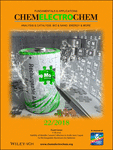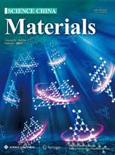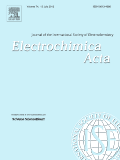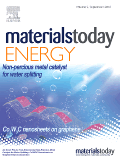
ChemElectroChem
Scope & Guideline
Fostering collaboration in the realms of catalysis and electrochemistry.
Introduction
Aims and Scopes
- Electrochemical Energy Storage and Conversion:
The journal focuses on advancements in energy storage technologies such as lithium-ion batteries, sodium-ion batteries, supercapacitors, and redox-flow batteries, emphasizing innovative materials and systems. - Electrocatalysis:
Research on electrocatalysts for key reactions including oxygen evolution, hydrogen evolution, and carbon dioxide reduction is a significant area, exploring both noble and non-noble metal catalysts. - Electrochemical Sensors and Biosensors:
The development of electrochemical sensors for environmental monitoring, biomedical applications, and food safety is a core focus, highlighting the integration of nanomaterials and novel detection techniques. - Materials Science in Electrochemistry:
The journal publishes studies on the synthesis, characterization, and application of novel materials, including metal-organic frameworks, carbon nanomaterials, and transition metal oxides. - Computational Electrochemistry:
Theoretical and computational studies that provide insights into electrochemical processes, mechanisms, and material properties are also prominently featured. - Sustainable and Green Chemistry:
Research that addresses sustainability in electrochemical systems, such as the use of renewable materials and processes for energy conversion and storage, is increasingly important.
Trending and Emerging
- Hybrid Energy Storage Systems:
There is a growing interest in hybrid systems that combine different energy storage technologies, such as lithium-sulfur batteries and supercapacitors, aiming to enhance energy density and performance. - Electrochemical Carbon Dioxide Reduction:
Research focused on the electrochemical reduction of CO2 into valuable chemicals is rapidly increasing, driven by global sustainability goals and the need for carbon-neutral technologies. - Advanced Electrode Materials:
The development of novel and functionalized electrode materials, including 2D materials and nanocomposites, is a significant trend, as researchers seek to improve performance and efficiency in various electrochemical applications. - Machine Learning and Artificial Intelligence in Electrochemistry:
Machine learning techniques are increasingly being applied to predict material properties and optimize electrochemical processes, suggesting a fusion of computational methods with experimental electrochemistry. - Biomimetic and Bioinspired Systems:
There is an emerging focus on biomimetic and bioinspired approaches to electrochemical systems, leveraging natural processes for improved efficiency and sustainability in energy conversion and storage.
Declining or Waning
- Traditional Organic Electrosynthesis:
Research focused solely on organic electrosynthesis without integrating modern materials or techniques has seen a decrease, likely due to the growing emphasis on more innovative and sustainable approaches. - Noble Metal Catalysis:
While still relevant, there is a noted decline in the dominance of noble metal catalysts in favor of more sustainable non-precious alternatives, reflecting a shift in research priorities towards cost-effective and environmentally friendly solutions. - Basic Electrochemical Theory:
Papers centered on fundamental electrochemical theory without practical application or novel insights are becoming less common, as the focus shifts towards applied research with immediate societal impact. - Low-Efficiency Energy Systems:
Research on low-efficiency energy systems that do not leverage new materials or technologies is less prevalent, as there is a strong push towards high-performance and scalable solutions.
Similar Journals

Journal of the Korean Electrochemical Society
Pioneering Insights into Electrochemical Processes and MaterialsJournal of the Korean Electrochemical Society (ISSN: 1229-1935, E-ISSN: 1229-1935) stands as a prominent publication in the rapidly evolving field of electrochemistry. Published by the prestigious Korean Electrochemical Society, this journal serves as a vital platform for researchers, professionals, and students eager to disseminate and access cutting-edge studies related to electrochemical processes, materials, and technologies. With an emphasis on promoting innovative research and practical applications, the journal aims to foster collaboration and knowledge exchange within the global electrochemistry community. Although not an open access journal, it provides comprehensive and rigorous peer-reviewed content that ensures the highest scientific quality, making it a valuable resource for anyone involved in the field. Located in Seoul, South Korea, it continues to contribute significantly to the advancement of electrochemical sciences, addressing key challenges and developments that shape the future of technology and environmental sustainability.

Portugaliae Electrochimica Acta
Fostering Connections in the Evolving Field of ElectrochemistryPortugaliae Electrochimica Acta is a distinguished journal dedicated to the field of electrochemistry, published by the SOCIEDADE PORTUGUESA ELECTROQUIMICA. With a notable ISSN of 0872-1904, this journal serves as a vital resource for researchers, professionals, and students interested in advancing their understanding of electrochemical processes. Though it is currently categorized in Q4 in the 2023 Electrochemistry rankings, the journal contributes significantly to the academic discourse from its base in Coimbra, Portugal. The journal's timeline spans actively from 2008 to 2025, ensuring a sustained engagement with emerging research. While the journal does not offer open access options, it remains an authoritative source noted for promoting innovative electrochemical research and fostering academic connections within the discipline. Researchers are encouraged to submit their findings and explore the latest contributions to this expanding field.

Energy & Environmental Materials
Exploring the Nexus of Energy Efficiency and Environmental StewardshipEnergy & Environmental Materials, published by WILEY, is an esteemed academic journal dedicated to pioneering research in the multifaceted domains of energy, environmental science, and materials science. Since its inception in 2018, this journal has rapidly established itself as a leading platform, holding a prestigious Q1 ranking across multiple categories including Renewable Energy, Sustainability, and Waste Management, reflecting its significant contributions to advancing knowledge in these critical areas. With a robust Scopus ranking that positions it in the top percentile for Environmental Science and Materials Science, it caters to a diverse audience of researchers, professionals, and students seeking cutting-edge findings and practical applications in energy efficiency and sustainable materials. This open-access journal facilitates the dissemination of innovative research and aims to bridge the gap between scientific exploration and real-world solutions for a sustainable future. The editorial team encourages submissions that explore both theoretical and practical aspects, ensuring that every publication not only contributes to the academic landscape but also drives impactful change in energy and environmental practices.

Battery Energy
Pioneering Research for a Greener Energy Future.Battery Energy is a pioneering open-access journal established by Wiley in 2022, dedicated to the dynamic field of energy storage and battery technologies. With an E-ISSN of 2768-1696, this journal plays a pivotal role in disseminating innovative research and advancements pertinent to the energy sector, including renewable energy solutions and sustainability practices. It holds a respectable position in Scopus rankings, being placed 32nd out of 78 in the Energy category and 130th out of 270 in Renewable Energy, Sustainability, and the Environment, showcasing its growing impact within the academic community. The journal aims to provide an inclusive platform for researchers, professionals, and students to share insights, foster collaboration, and tackle the pressing challenges associated with battery energy storage. By promoting open access, Battery Energy ensures that cutting-edge research is readily available to a global audience, facilitating the continued evolution of battery technologies for a sustainable future.

RUSSIAN JOURNAL OF ELECTROCHEMISTRY
Fostering Knowledge in the Dynamic World of ElectrochemistryThe Russian Journal of Electrochemistry, published by Pleiades Publishing Inc, is a reputable scientific resource that caters to the dynamic field of electrochemistry. Since its inception in 1996, this journal has become a platform for the dissemination of cutting-edge research, exploring both foundational studies and innovative applications within electrochemical science. Despite currently holding a Q4 categorization in its field, the journal is dedicated to enhancing its scholarly impact and visibility, reflecting its commitment to fostering advancements in electrochemical technologies. With its ISSN 1023-1935 and E-ISSN 1608-3342, the journal strives to reach a global audience of researchers, professionals, and students alike. Though the journal is not open access, its contents are crucial for anyone looking to stay at the forefront of electrochemical research and developments. The journal's editorial board includes well-respected experts, ensuring that published articles contribute significantly to the scientific community and pave the way for future innovations in the field.

Energy Material Advances
Fostering Knowledge for a Greener FutureEnergy Material Advances, published by the American Association for the Advancement of Science, stands at the forefront of energy research, showcasing groundbreaking studies in the realm of renewable energy, fuel technology, and materials science. With the journal's commitment to open access since 2020, it aims to democratize knowledge and foster innovation across a global community of researchers, professionals, and students. The journal boasts an impressive impact factor, placing it firmly within the Q1 category across multiple disciplines including Energy (miscellaneous), Fuel Technology, and Renewable Energy, Sustainability and the Environment, highlighting its significance in advancing scholarly discussions. In the latest Scopus rankings, Energy Material Advances ranks among the top 10% of journals in its field, affirming its role as a pivotal resource for current and emerging trends in energy materials. The journal is dedicated to facilitating collaborative efforts and inspiring novel approaches to the challenges posed by energy sustainability and technological advancement.

Science China-Chemistry
Unveiling Breakthroughs in Chemical ResearchScience China-Chemistry, published by SCIENCE PRESS, stands as a leading journal in the field of chemistry, specifically recognized for its contributions in miscellaneous chemistry domains. With an impressive Q1 categorization in the 2023 quartiles and ranking at #35/408 in general chemistry by Scopus, this journal places itself within the top 91st percentile, showcasing its significant impact in the discipline. The journal, based in Beijing, China, provides a platform for innovative research, reviews, and insights that cater to an international audience of researchers, professionals, and students dedicated to advancing chemical science. As an open-access journal, it ensures widespread dissemination of knowledge, making cutting-edge research accessible to all. With converged years from 2010 to 2024, the journal continues to be a vital resource for those engaged with the latest developments in chemistry.

Science China-Materials
Pioneering Research for a Sustainable Tomorrow.Science China-Materials is an esteemed peer-reviewed journal dedicated to advancing the field of materials science, published by SCIENCE PRESS. With a strong focus on innovative research and applications, this journal provides an essential platform for disseminating groundbreaking findings in materials development, characterization, and engineering. Since its inception, Science China-Materials has achieved an impressive Q1 ranking in the Materials Science (miscellaneous) category, reflecting its commitment to quality and the impact of its publications, as indicated by its 86th percentile ranking in Scopus. The journal is set to converge its contributions from 2016 to 2024, making it a vital resource for researchers and professionals interested in the latest advancements and trends in materials science. As an open access publication, it ensures that knowledge is freely available to a global audience, promoting collaboration and innovation across disciplines. The journal is headquartered in Beijing, China, and continues to attract high-quality submissions from leading experts in the field.

ELECTROCHIMICA ACTA
Unveiling the Future of Electrochemical ApplicationsELECTROCHIMICA ACTA is a prestigious academic journal dedicated to the field of electrochemistry and chemical engineering. Published by PERGAMON-ELSEVIER SCIENCE LTD, this journal stands out with its impressive impact factor and is categorized in the top quartile (Q1) for both Chemical Engineering and Electrochemistry in 2023, further cementing its role as a leading venue for cutting-edge research. With a publication history dating back to 1959 and converging into 2024, it has established a substantial archive of influential articles that explore various aspects of electrochemical processes, materials, and applications. Researchers and professionals in the field benefit from the journal’s high visibility, as it ranks remarkably well according to Scopus metrics, with a position in the 90th percentile for General Chemical Engineering and 84th percentile for Electrochemistry. Although ELECTROCHIMICA ACTA does not currently offer open access, it continues to serve as a vital resource for those seeking to expand their knowledge and explore innovative developments in electrochemical science.

Materials Today Energy
Innovating Energy Materials for a Sustainable FutureMaterials Today Energy is a premier journal published by Elsevier, focusing on the interdisciplinary field of energy materials. With an ISSN of 2468-6069, the journal is renowned for its impactful research as evidenced by its impressive Q1 quartile rankings in multiple categories including Energy Engineering and Power Technology, Fuel Technology, and Renewable Energy. It stands out with strong Scopus rankings, highlighting its significance in the respective research communities, such as being ranked 3rd in Nuclear Energy and Engineering. Established from 2016 to 2024, the journal aims to provide a platform for innovative research that addresses the global demands for sustainable energy solutions. Although it is not open access, Materials Today Energy is accessible to a broad audience, encouraging collaborations among researchers, professionals, and students in the pursuit of advancing materials science and energy technologies. This makes it an essential resource for those looking to remain at the forefront of discoveries that shape the future of energy.